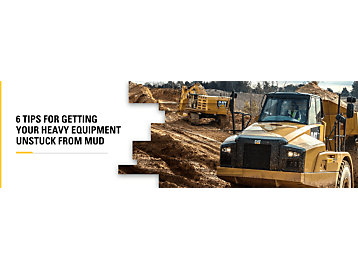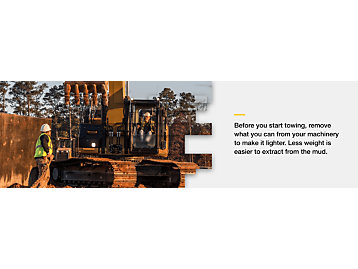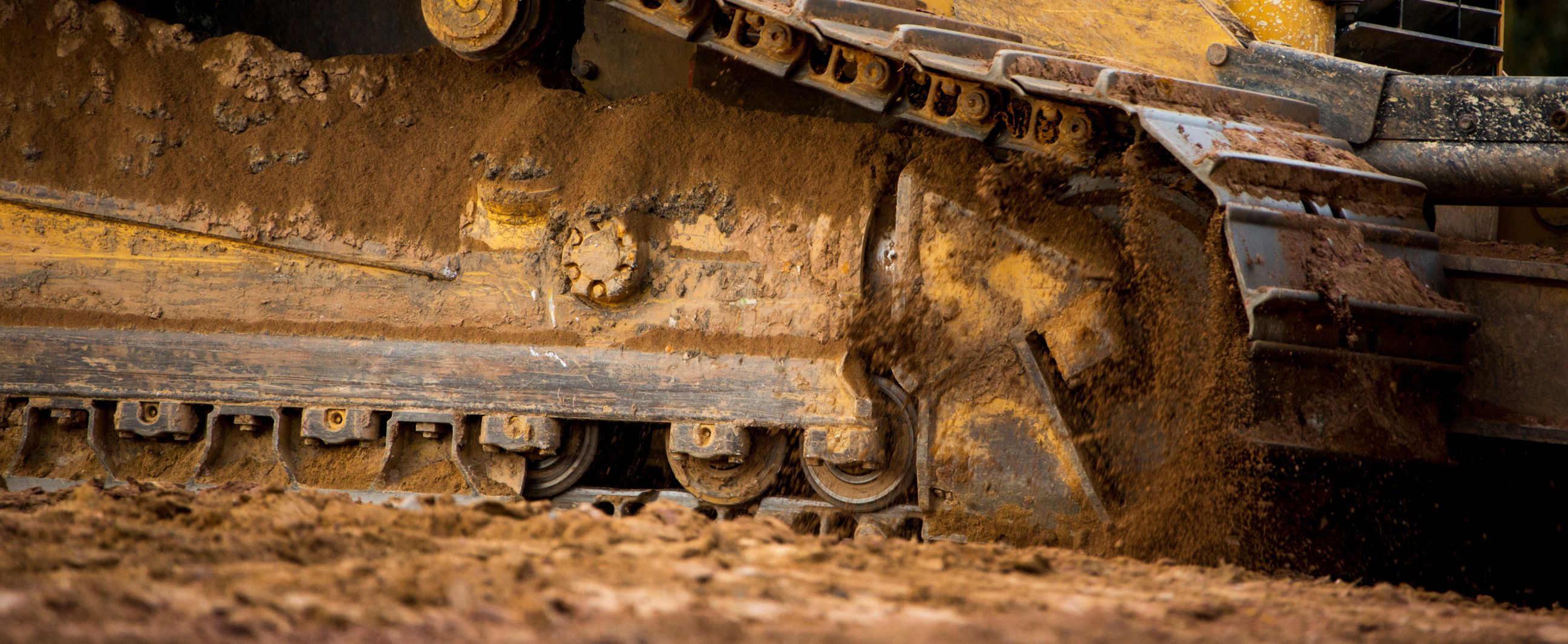

Sign In
Welcome! Sign In to personalize your Cat.com experience
If you already have an existing account with another Cat App, you can use the same account to sign in here
Register Now
One Account. All of Cat.
Your Caterpillar account is the single account you use to log in to select services and applications we offer. Shop for parts and machines online, manage your fleet, go mobile, and more.
Account Information
Site Settings
Security
Author: Small Business Expert | June 29, 2023 | Topic: Used Equipment

If you're working in wet conditions or rain, your heavy equipment can get lodged in the mud or damp soil. Stuck equipment isn't usable, and you'll have to spend time, money and labor getting it free.
Learning how to get your equipment out of the mud is essential to reduce downtime and increase productivity. Below, you'll learn tips to extract machinery from mud and how to prevent your equipment from getting stuck.
How to Avoid Getting Stuck in the Mud in the First Place
Extracting stuck equipment from the mud can be tedious and waste valuable time and money. Additionally, nobody wants to toil with heavy equipment if they don't have to, which is why it's essential to take steps to prevent getting stuck in the mud in the first place.
- Inspect your work site: Before starting work, take some time to examine your job site and the terrain your equipment will be working on. If you notice any areas with sticky soil or mud, you'll want to mark them off so equipment operators avoid taking their heavy machinery in that area.
- Clean your equipment: Remove any debris or mud collected on your equipment's tires, tracks or undercarriage at the end of each workday and between jobs. Taking this step can help improve traction when working in wet conditions.
- Use the proper equipment: Use tracked excavators and compact track loaders when possible to reduce how much your equipment disturbs the ground at your job site. Wider tracks can improve traction and flotation, reducing the impact on the ground and making them ideal for mud or soft soil.
Tips for Getting Equipment Unstuck
While it's possible to take steps to prevent your equipment from getting stuck in the mud, it can still happen, so you'll want to prepare for the eventuality. Use the following tips to get heavy equipment out of the mud or soft soil.
1. Have the Proper Recovery Tools on Hand
The first thing you need to do to get heavy equipment out of the mud is to ensure you have the proper recovery tools on your job site, including straps, ropes, cables or chains. These tools should be durable enough to tow your machinery without breaking or snapping.
2. Get Your Towing Vehicle as Close as Possible
Since a shorter connection is less likely to cause damage from flying debris, you'll want to get your towing vehicle as close as possible to your heavy equipment. Still, ensure your attachments are long enough to keep your towing vehicle on the ground, whether you're using chains, straps, cables or ropes.
3. Remove What You Can to Make the Equipment Lighter
Before you start towing, remove what you can from your machinery to make it lighter. Less weight is easier to extract from the mud, reducing the strain on your recovery tools, towing vehicle and heavy equipment. Take out any removable components, worker items and excess equipment or tools.

4. Attach Your Recovery Tools to the Correct Location
One of the ways to get equipment unstuck from mud is to attach your recovery tools to the appropriate connection point. Hooking your recovery tools to the correct spot on your equipment can protect your heavy machinery and towing vehicle. You'll want to connect your straps or a tow hook to the frame to get your equipment out of the mud and reduce the risk of damage.
5. Use Two Attachment Points
Whenever possible, you should only use two attachment points — your stuck equipment and the towing vehicle. The fewer attachment points you have, the better your recovery equipment will work. Ensure your straps, chains, cables or ropes are flat and have no knots. Tying the recovery equipment together can also reduce its overall power, making it more challenging tow.
You'll also want to ensure you're towing slowly and in a straight line. If you pull too quickly or at an angle, your attempt to extract your equipment from the mud might be unsuccessful.
6. Dig Mud Away
If you're struggling to get your equipment out of the mud, you may want to try digging out the tires or tracks. Shovel the mud from the front and back of the wheels to help loosen up the equipment. Placing boards behind the wheels can provide traction to get the machine unstuck from the mud.
What to Do After You've Extracted Your Stuck Equipment
Once you've got your equipment out of the mud, there are a few steps you need to take to ensure your equipment is undamaged and in good condition. Some of the tasks you should complete after extracting your equipment include:
- Inspect for damage: The first thing you'll want to do is to check for damages caused by towing. The deeper your equipment gets lodged in the mud, the more essential the inspection is. You'll want to check components such as the lights, hoses, brake lines, spinner and exhaust systems.
- Clean the equipment: On top of any inspection, you'll also want to clean your machinery. Leaving caked-on mud in place can increase wear and tear. Clean equipment also makes your business look more professional.
- Clean your recovery tools: Your recovery tools likely got dirty when towing equipment out of the mud. Cleaning them will prevent any unnecessary wear that can cause damage.
Browse Cat Used for High-Quality Pre-Owned Equipment
If you're looking for used heavy equipment, Cat Used can help. We offer a wide selection of used equipment including construction and mining, power systems, transportation and agriculture equipment. You can find a Cat® dealer in your area to learn more about a piece of equipment or ask any questions. You can also sign up for email alerts to know when a piece of equipment you're looking for becomes available.
If you don't want to invest in brand-new machinery, we can help you find equipment that suits your business needs without hurting your budget. Browse our catalog today or find a dealer in your area.


